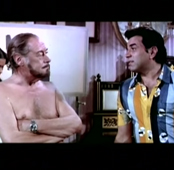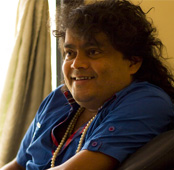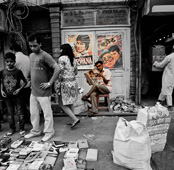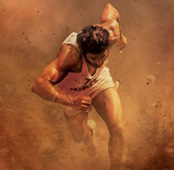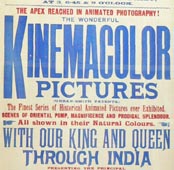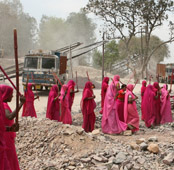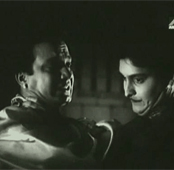-
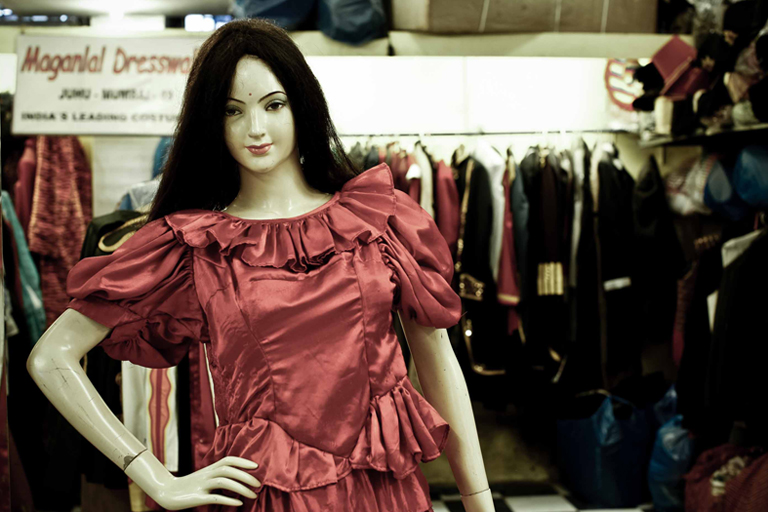 Mannequin at the Maganlal Dresswalla workshop
Mannequin at the Maganlal Dresswalla workshop -
 Mannequin with props for hire
Mannequin with props for hire -
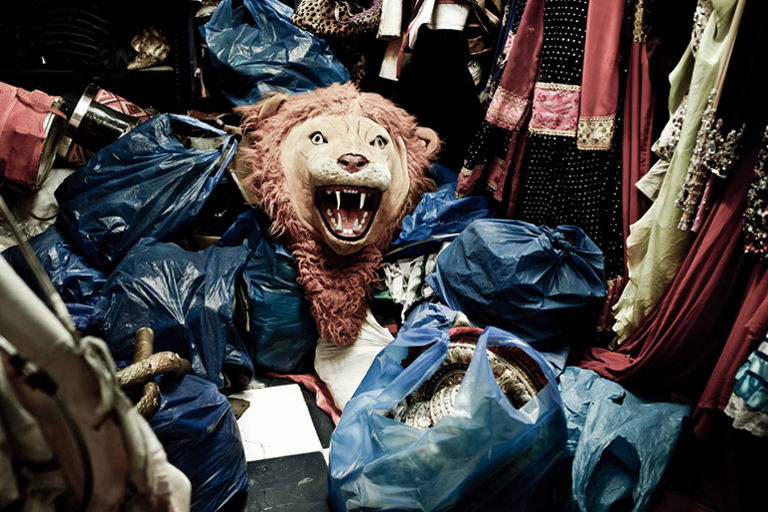 Masks and head gears rented, waiting to be picked up
Masks and head gears rented, waiting to be picked up -
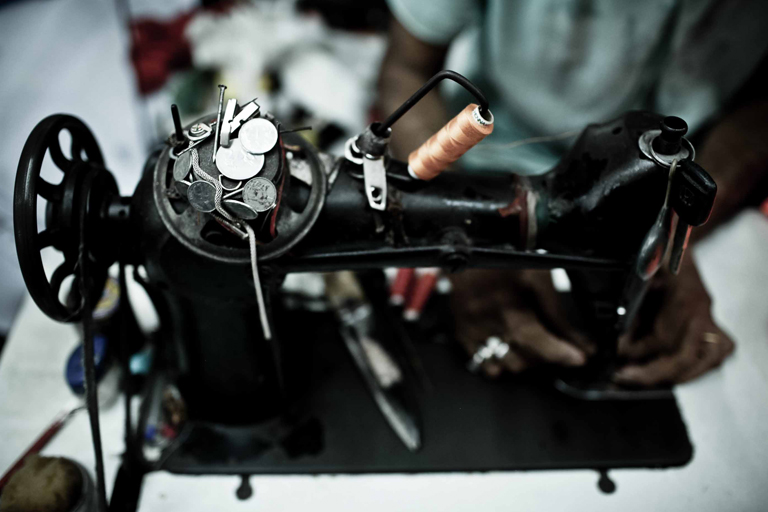 Sewing machine of one of the tailors who custom make clothes and accessories
Sewing machine of one of the tailors who custom make clothes and accessories -
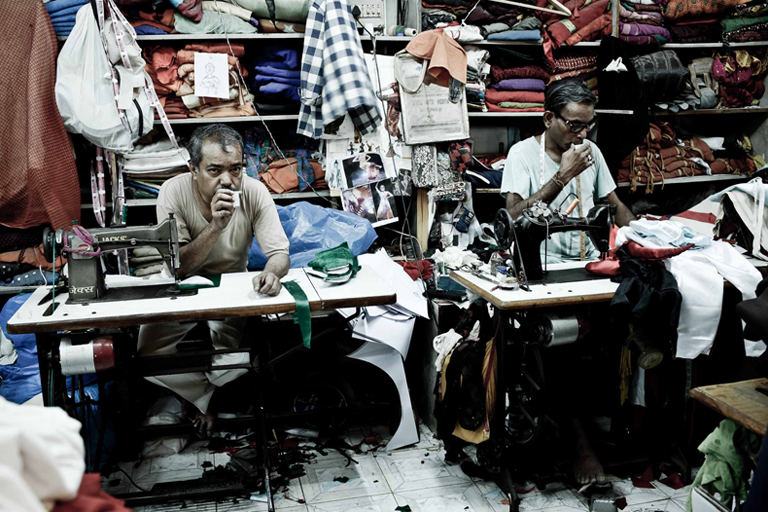 Tailors enjoying their chai in their break
Tailors enjoying their chai in their break -
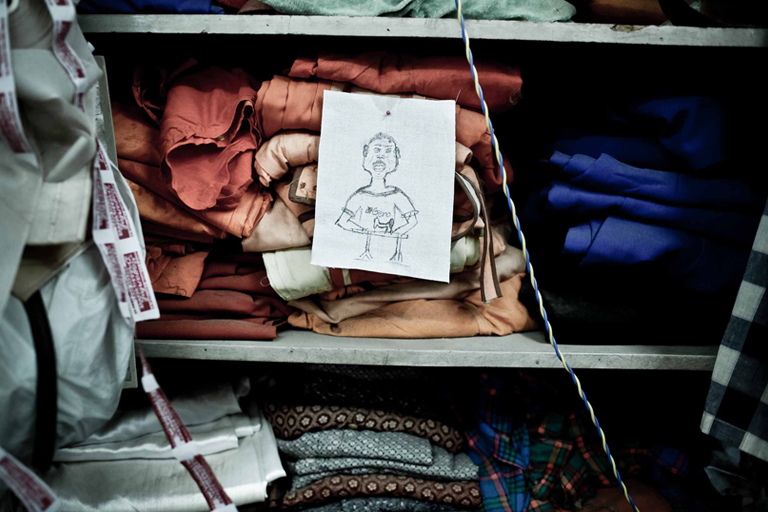 A sketch made by a fellow tailor
A sketch made by a fellow tailor -
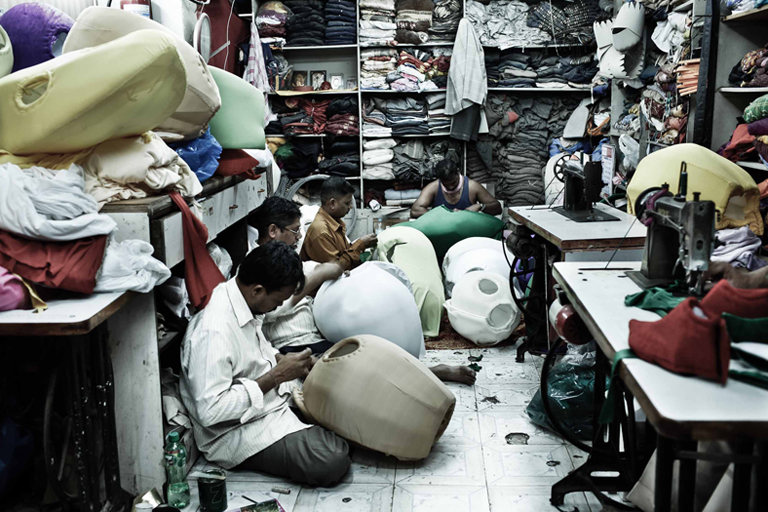 Tailors stitching some props for a bulk order
Tailors stitching some props for a bulk order -
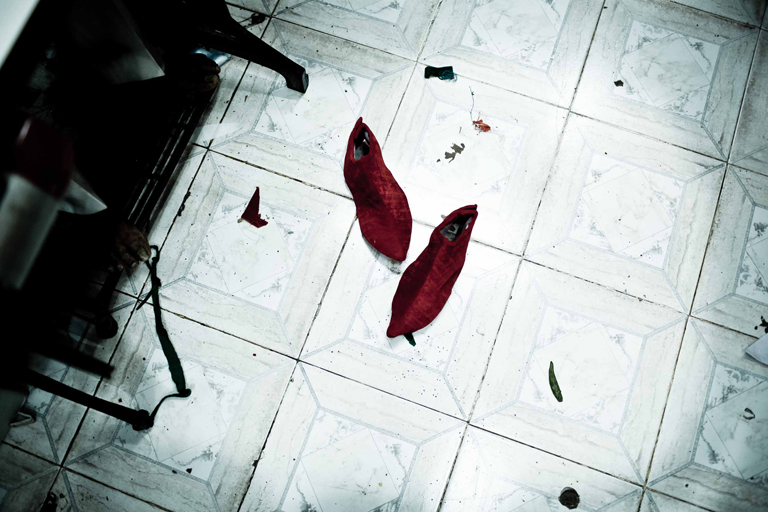 Red shoes
Red shoes -
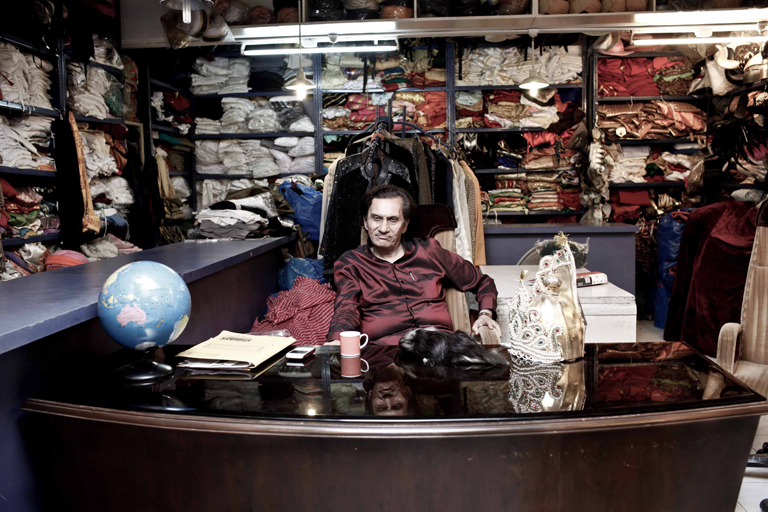 Suresh Dresswalla in his office
Suresh Dresswalla in his office -
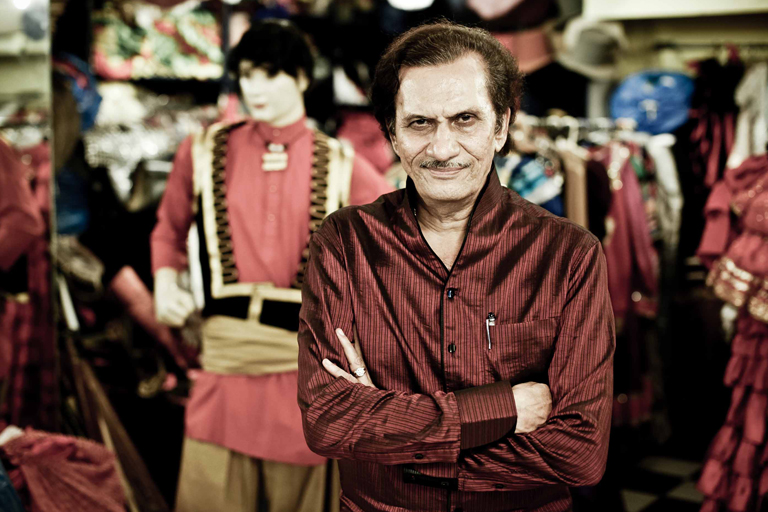 Suresh Dresswalla standing in his workshop
Suresh Dresswalla standing in his workshop -
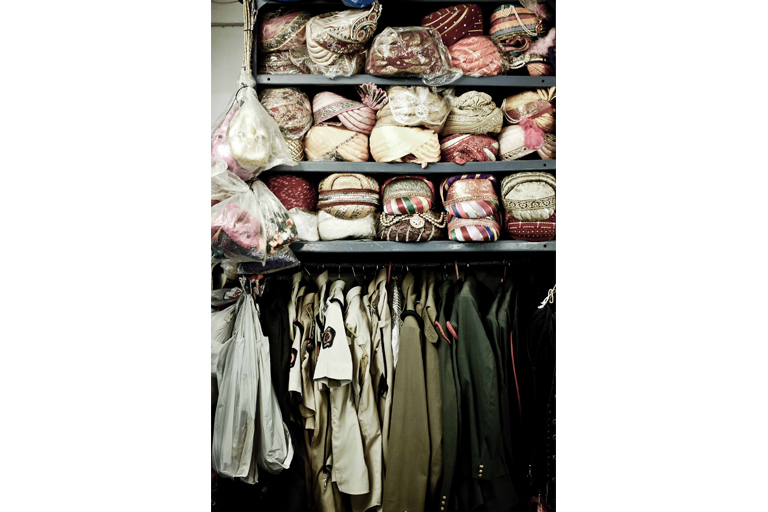 Rental Pagdis and police outfits stacked up in shelves
Rental Pagdis and police outfits stacked up in shelves
For over eight decades, Maganlal Dresswalla has created costumes for the best known Hindi, South Indian and even Hollywood movies. Akshay Manwani brings to you the story of a legend.
Maganlal Dresswalla is not difficult to find. In Mumbai’s posh suburb of Juhu, on the Vainkunthbhai Mehta Road that connects the city’s iconic Prithvi Theatre to the eminent Nanavati Hospital, it is situated in the middle of a bustling shopping complex. The number of vehicles the complex attracts has the effect of slowing down, dramatically, the pace of traffic on this thoroughfare.
And yet, the high profile of its neighbours, on either side, leads visitors to walk past Maganlal Dresswalla, without so much as casting a look in its direction. Situated right between Kala Niketan, a famous sari store, and two designer couture boutiques, Jesal Vora and Archana Kochhar, Maganlal Dresswalla does precious little to battle the ethnic charm of the former or the contemporary glamour of the latter. Where the bedecked mannequins within the glass facade of these three outlets entice many a passer-by into paying the shops a visit, the words ‘Maganlal Dresswalla’, inscribed on a solitary rusted metal hoarding that stands a few metres before the narrow entrance to its basement premises, appear more like a warning for construction being carried out at a site than the sign for an institution that has been an intrinsic part of the history of Indian show business.
But the moment you make your way down the flight of stairs, from this inconspicuous facade into the sprawling 3000 square feet plus premises of Maganlal Dresswalla, you are transported into another realm. The feeling is that of a Harry Potter-finds-himself-on-platform-nine-and-three-quarter experience, where visitors, much like JK Rowling’s protagonist, are left wide-eyed at what lies before them. A swan-shaped wedding palanquin greets you as you step off the staircase. Beyond it lies an unlikely landscape steeped in colour— a variety of costumes, turbans, masquerade masks. Piles of wooden and metallic bows, arrows, maces, spears, bayonet-laden-rifles are stacked up in one corner. The sound of tailors working away frenetically at their sewing machines can be heard from the other end. The space is brightly lit— a glow of yellow light accentuating the ornate interiors of the shop.
It is from here that Maganlal Dresswalla serves the requirements of Mumbai’s film and television industry. Its association with Hindi cinema dating way back to 1926. The family that has founded and runs this enterprise is not so much an overlooked chapter of the industry’s history, as a quintessential and ongoing participant in the evolution of cinema for so long that its presence has perhaps been taken for granted. From Indian films like India’s first talkie Alam-Ara (1931), to Mughal-e-Azam (1960), to Jewel Thief (1967) to the more recent Jodhaa Akbar (2008), Hollywood movies like Steven Spielberg’s Close Encounters of the Third Kind and Life of Pi, TV shows like Shyam Benegal’s Bharat Ek Khoj and B. R. Chopra’s Mahabharat to innumerable regional language movies, Maganlal Dresswalla has provided costumes to hundreds of characters, protagonists as well as extras, for close to 90 years, working closely with filmmakers such as K. Asif, Shyam Benegal and Ashutosh Gowarikar.
***
Suresh Dresswalla, 67, is the man at the helm of Maganlal Dresswalla today. Even on this lazy Sunday afternoon he is carefully dressed in a silk maroon full sleeved shirt with a mandarin collar and black pin stripes, dark brown trousers and a pair of formal black shoes— all seeming to reinforce his Dresswalla credentials. We are seated on either side of a wooden desk, with a reflective glass panel on top, in the section of the premises reserved exclusively for film costumes. Garments of various hues are stacked in metal racks along the walls behind him and to his right. To my right, a female mannequin, dressed in Kimi Katkar’s sultry red flamenco outfit from the widely popular Jumma Chumma number in Hum (1991), catches my attention, as Suresh bhai, as he is called, begins speaking.
“Kya hai ke, pehley jo hai na, before 1926, mere daddy aur unke bhaisaab, gaon mein pagdi baandhte thay— shaadi byaah ho ya koi function ho (Earlier, before 1926, my father and uncle would tie turbans at weddings and other functions at their village),” Suresh bhai tells me in a hoarse voice, laced with a distinct Gujarati accent. Hailing from Dhari village in the Saurashtra region of Gujarat, the two brothers worked their way into Mumbai’s film industry, making a name for themselves in the turban business. “Us zamaaney mein gents hi ladies ka role kartey thay, as a heroine (At that time, men played female characters in films). Maganlal Dresswalla is established since then.”
There are other tidbits that emerge— like how the firm got its name. “My father’s name was Harilal. Maganlalji was his elder brother. The business was in the company’s name, which my father was handling,” Suresh bhai tells me. The story of how Dresswalla was incorporated into the firm’s identity, which Suresh bhai tells me, with a hint of pride in his voice, involves his father going to meet a film producer at his office. The producer made Harilal wait. “Daddy ko achcha nahin laga. Appointment lekar aaye thay. Toh unhoney turant bola, ‘Mujhe bulaaya gaya hai isi liye aaya hoon. Unko time nahin hai toh main jaata hoon (Daddy did not appreciate being made to wait. He had an appointment. He said, ‘I have been called here and that is why I have come. If he does not have time, I will leave.).’” When the message was relayed to the producer, he said the ‘tailor’ should wait patiently for another 10-15 minutes. To this, an angry Harilal’s parting repartee to the producer, which went on to define his enterprise, was: “I am not a tailor. I am Dresswalla. Mere paas sau-sau tailor kaam kartey hain (Hundreds of tailors work for me).” It is this pride in their work that has kept Maganlal Dresswalla going in the entertainment business for over three generations. The commitment to their craft, their work is something shared by their employees as well. Their expertise in mythologicals and period films, built over the past several decades, doesn’t stem from their ingenuity alone, but from hard work, too. “We study literature, photos, books with designers,” Suresh bhai tells me, explaining his commitment to respond to any kind of costume requirement.
***
‘Tailor’ is used as a generic term by Suresh bhai. It describes the array of people—tailors, cobblers, metal and fibre craftsmen— Maganlal Dresswalla employs and works with to execute costume requirements in films. Eventually, the scope of Maganlal’s services was broadened to include the entire gamut of livery, headgear or weapons that formed a part of a character’s appearance in a film. Suresh bhai extracts, from his fading memory, a cursory list of names of the films Maganlal Dresswalla has been associated with over the last nine-odd decades.
“All the costumes in Mughal-e-Azam were ours. Kranti (1981) as well. Babubhai Mistry’s Sampoorna Ramayan (1961) and Mahabharat (1965) had a lot of our costumes,” he says, taking long pauses while recalling these films. Then, suddenly, he remembers, “The dacoit costumes in Sunil Dutt’s Mujhe Jeene Do (1963) and Vinod Khanna’s Mera Gaon Mera Desh (1971) were done by us.” In the next instant, he names a film from an entirely unrelated genre: “The side artistes in Ajooba (1991), the crowds in the film, their costumes were done by us.” From the present day, he speaks of Jodhaa Akbar. “The turbans for most of the main artistes were done by us,” he says. “Ashutosh Gowarikar khud aaye thay selection ke liye (Ashustosh Gowarikar himself came to select the turbans).” Suresh bhai adds: “We have easily done more than 100 films. Itne kiye hain ki abhi mind mein hai bhi nahin (We have done so many, that it’s easy to forget them).”
However, when I ask which film so far has posed the greatest challenge for the Dresswallas, he talks of television. He cites Shyam Benegal’s Bharat Ek Khoj (1988). “What would happen is that every 10 days, the show’s period would change. That meant the character’s turbans, their dhotis, everything changed.” In order to deal with this constant state of flux, Suresh bhai stationed more than a dozen craftsmen in Mumbai’s Film City, where the serial was shot, who often worked through the night to meet production requirements. “It was a very tedious job,” he says. “But I did my best.” He adds, almost shyly, “Shyam babu ne mujhe gold medal bhi diya thaa uske liye (Shyam Benegal even gave me a token of appreciation for my efforts).”
Suresh bhai is a ready reckoner on material that has been used to dress up artistes over the years. While speaking of Mughal-e-Azam, he tells me that Prithviraj Kapoor’s armour for the war scenes weighed in excess of 50 kgs. “In those days, armours were made of iron. Today, they are made of aluminium.” Similarly, he explains, crowns worn by kings or divine characters today, have thermocol, instead of metal, as the base frame material, to make them lighter on the actors’ heads.
He talks of how K. Asif kept telling his father, Harilal, during the making of Mughal-e-Azam, with great conviction, that the same film that had landed him in a penurious state, would deliver him from it. (The film, started in 1944 and released in 1960 was made on a whopping budget of Rs. 1.5 crores has since become a cultural milepost in our cinema for its grandeur, scale and beauty.) Or how Dilip Kumar insisted, unreasonably at times, on having Suresh bhai, who was then a young man, present on set to tie his turban throughout the shooting schedule of Manoj Kumar’s period drama, Kranti (1981). But the one memory that stands out for him revolves around the 1975 mythological blockbuster Jai Santoshi Maa. The episode, besides highlighting the fickle nature of luck in the movies, is also a telling comment on the urge to repeat a successful ‘formula’ to death in the industry.
“Usme maje ki baat kyaa thi (What was interesting about it was),” says Suresh bhai, sitting up in his chair in excitement, “Ashish Kumar, Jai Santoshi Maa ’s hero, made Solah Shukrawar (1977),” a rehashed version of Jai Santoshi Maa, which he hoped would cash in on the former film’s success. Kumar even called his production house Santoshi Maa Pictures. And Maganlal Dresswalla, who had done costumes for the previous movie, were called upon for this one as well. But the film tanked. “Yeh taqdeer ki baat hai, ki yeh (Jai Santoshi Maa )superhit gaya aur usi ka hero, jo khud film banaaya, us type ka, woh flop ho gaya (This is destiny, that while Jai Santoshi Maa was a hit, a similar film, made by its hero, tanked).”
***
Tea arrives. The conversation changes track. Suresh bhai says he lost his father, Harilal, almost 13 years ago. Maganlal, his father’s elder brother, had passed away much before that, “Some time in the 1940s or 1950s, I don’t know.” Until seven years before Harilal’s passing, the family had continued to operate from the first Maganlal Dresswalla premises in Bhuleshwar, a crowded neighbourhood close to Kalbadevi in South Mumbai, also famous for being the early residence of the Dhirubhai Ambani family. Suresh bhai and his father Harilal moved from there to Juhu only in 1993, when the Indian television industry was beginning to grow.
“I was doing Tipu Sultan (The Sword of Tipu Sultan, a historical drama on TV) at that time,” remembers Suresh bhai. Coming to South Bombay, with its constant traffic snarls, was a problem for producers, many of whom lived in the suburbs. “Sanjay Khan (director of The Sword of Tipu Sultan) would pester me regularly, saying you have to take up premises in Juhu. He would tell me, ‘Even if you take up a place on the fifth floor, aur lift nahin hoga, toh bhi hum chad ke aayengey (and there is no lift, I will still climb the stairs and come).’”
Before joining the business with his father, Suresh bhai went to Kishinchand Chellaram College in Mumbai’s Churchgate, from where he studied up to “Inter-Arts only (two years of college)”. He says he had a passion for acting in those days and performed in several college shows, but could not take up acting professionally because his father would not allow it. “Daddy ne thappad maar ke bitha diya shop pe (Daddy summarily dismissed the idea and made me sit at the shop),” he tells me, breaking into a wistful chuckle. His warmest memory from those days is of acting in a play whose title may be seen with some irony in hindsight: ‘Yadi drama na ho sakey, toh yaaron mujhe maaf karna (If the drama doesn’t take place, then friends please forgive me)’. He grins as he says the title out loud. “Jatin, means Rajesh Khanna (Hindi cinema’s first big superstar), was there; Amjad (Khan, a star villain) was there; Jeetu (Jeetendra, also a film star) was there (they were all acting in the play). We stood first in the inter-college competition.”
The other acting memory Suresh bhai recalls is when he dressed up as the Hindu god Krishna from B. R. Chopra’s television series Mahabharat, having provided costumes for the same. “Kabhi kabhi aisa lagta hai na, itne heroes ke costumes kiye, film mein, serial mein, mujhko khud yeh banna hai. Toh mujhe Mahabharat ka Krishna banna thaa (Sometimes you feel, you have done costumes for so many heroes, in film, in TV serials… you would like to be one of them. I wanted to be Krishna from Mahabharat ).” The opportunity to fulfill this whim came his way when an independent director, whose name Suresh bhai cannot recall, approached him for a short film. “I was in Bhuleshwar then… She made me wear Krishna’s costume and took me to Marine Drive where she asked the beggars to gather around me,” he says, laughing heartily at the idea. “She wanted to show the contrast— between the time of the Mahabharat, with its wealthy kings and prosperous setting, to the poverty in Mumbai today.”
While speaking of Marine Drive, Suresh bhai decides to clear the confusion created by two other Maganlal Dresswalla outlets in this part of South Mumbai. These, he explains, are run by his brothers, but have nothing to do with films (“They are not in Bollywood”). Kirti bhai, his elder brother, functions out of Marine Drive. “He is dealing mostly in school and college functions, fancy dress costumes for kids.” Girish bhai, the youngest of Harilal’s three sons, operates out of Bhuleshwar, but not from the original Maganlal Dresswalla premises. “He is doing exports to Middle East.” When I ask Suresh bhai what led to the division in the business, he says, “Daddy only said to do so.” He insists that all three siblings have been and continue to be on good terms with each other, but “now everything is separate.” The one time that I managed to connect with Girish bhai over the phone, he too ruled out any conflict between the brothers: “Whatever we are doing, we are satisfied. Whatever he is doing, he is satisfied.”
***
At the 2012 Mumbai Film Festival organized by the Mumbai Academy of Moving Image (MAMI), young, upcoming actor and filmmaker, Shriya Pilgaonkar’s Dresswala, a four-minute short film, was shown in the ‘Dimensions Mumbai’ section of the festival. Shriya had known of Maganlal Dresswalla for a long time as a place for costumes, but once she got to know of the films they had been associated with, she says, it became “like a heritage site” for her. “That is when I realized that I have to know more about this (place).”
While Shriya believes that the audience at MAMI left with a new perspective of Maganlal Dresswalla, she feels bad that not enough goes into preserving Maganlal’s legacy. “In the 2005 floods, a lot of their stuff was washed away,” she says. “In India, a thing like preservation is not taken very seriously. I wish there would be archives of these costumes for people to see.” Pilgaonkar’s statement is an echo of Suresh bhai ’s own regret, at the devastation brought about by the 2005 Mumbai floods, which obliterated records of their work not just in Hindi cinema, but in English films like Steven Spielberg’s Close Encounters of the Third Kind (1977) and in several Gujarati and South Indian language movies, including N. T. Rama Rao’s costume for Ashoka The Great (Samrat Ashok – 1992). “Sab ke album thay, photograph thay original, woh sab paani mein chale gaye. Khatam (We had albums of all our films, original photographs in them, but they were all destroyed in the floods. Finished.).”
Presently Suresh bhai is more focused on the television industry, which for him takes precedence over films. He says this is due to a decline in the quantum of period and mythological films being made today. “Aajkal Western type kay… ya Las Vegas type kay… toh woh costumes zyaada chaltay hain. Woh type ke costumes main nahin karta (Nowadays, Western costumes, Las Vegas style costumes, are in greater demand. I don’t do those kinds of costumes),” he says about costumes in today’s movies. His discomfort is especially reflected in the way the words ‘Las Vegas type’ stumble off his tongue, with great reluctance, as if by merely mentioning the phrase he is compromising on a value system. “But I do a lot of TV serials. Sagar Arts ne jitney Devi Ma ke upar serials banaaye, usme mostly maine saarey main lady artists ke costumes diye hain (Whatever mythological serials have been produced by Sagar Arts around Devi Maa—the Hindu goddess—I have given the costumes for most of the main female protagonists),” he adds, immediately.
Forty-five minutes into our conversation, we are joined by the younger of Suresh bhai ’s two daughters, Sarika Dresswalla, 36, who is visiting the premises on this Sunday evening with her husband, a banker. Like her elder sister Rupal Dresswalla, Sarika has been involved in the business for more than a decade now. “As a child, this was like a dreamland for me,” she says. Her face lights up at the memory. “Every time papa would call me to the shop, even if it was in the middle of the night, I would be ready because there was so much going on. So many colours, so many costumes. It was like a passion for me, it was in the blood.”
As Suresh bhai gets up to attend to matters of business, Sarika gives me a tour of the premises. She begins with the film section, right behind the mannequin styled like Kimi Katkar from Hum. A wide array of outfits are on display here, iconic costumes that have been worn by heroes and heroines over the years. Amitabh Bachchan’s Shahenshah jacket, with netted-metallic material on the right arm and a rope that the character usually carries in his left hand, stands out. Another female mannequin is dressed as Madhubala’s Anarkali from Mughal-e-Azam. Then there is Aamir Khan’s Elvis Presley outfit from the song ‘Tere pyaar ne kar diya deewaana ’ in the 2011 film, Delhi Belly. But these are duplicates, made by tailors at Maganlal Dresswalla to cater to the rising demand for Bollywood themed parties. They allow people to relive their favourite film characters vicariously. “Everyone has a dream. Everyone wants to become something,” says Sarika. “And when they come here, we bring their dream to life.” The costumes also represent new avenues of business being developed by the Rupal and Sarika, the third generation of Dresswallas.
“I want to expand into foreign films. That’s my dream,” says Sarika, when asked about her vision for Maganlal Dresswalla. “There’s such beautiful work that we do here and I think we can offer so much more to them (foreign films). I’ve already done foreign films— supplied costumes for Mission: Impossible Ghost Protocol (2011, for a section that was set in India) supplied for Life Of Pi (2012)— about 400 to 500 school uniforms.”
Rupal, who I spoke to a few days later, spoke of plans for expansion as well. She pointed out how Maganlal Dresswalla today helps create mascots for brands such as Bournvita and Colgate, an initiative driven entirely by Sarika and her. Rupal is older than Sarika by four years. She did a course in fashion design from the J. D. Institute Of Fashion Technology before joining the family business. She says that since her husband, Gujarati superstar Hitu Kanodia, is part of the entertainment industry, “it helps”. “We are 21st century women. Once you are married, you need to know how to balance your life,” she added, in a measured way.
***
As we near the end of the quick look around the Maganlal Dresswalla premises, Sarika mentions the store is about to undergo a complete overhaul. “What I am trying to do is… ” she begins to outline her plans— essentially a more compact, functional and organized premises, suited to the next generation of Dresswallas. Her zest sits well with Suresh bhai ’s own plans as he nears 70 and looks to his children to take the legacy forward. “My ambition is that both my kids – Rupal and Sarika, woh dono bahut aagey badhey film industry mein, badi badi filmein karey (go a long way in the film industry and do good work),” he had said earlier. From an idea that began at a time when even female characters in the movies were portrayed by men, to an institution that now sits on the shoulders of two confident young businesswomen, the Dresswallas have had an eventful journey.
Nothing is quite the same since when they started. In the last two decades Hindi films have become glossier and slicker. Every star today has his or her own stylist, as does every film. The fashion industry is of global standards in India now and almost all the top designers are involved with the movies. The large number of fashion magazines in the market has cemented the bond between cinema and fashion. It is common practice to have makeup and prosthetics technicians flown down from Hollywood now and costumes in superhero films like Ra.One are generated by SFX. The space for traditional costumers like the Dresswallas is shrinking. But their significance is not. To have loved Hindi movies and their inimitable characters is to have loved Maganlal Dresswalla.
The Costumer Cometh
ArticleFebruary 2014
 By Akshay Manwani
By Akshay Manwani
Akshay Manwani turned to freelance writing after a brief career in the corporate world. His writings on popular Indian culture have appeared in The Caravan, Business Standard, Man's World and Mumbai Mirror. His book on the poet-lyricist Sahir Ludhianvi—Sahir Ludhianvi: The People's Poet—was published by Harper Collins last year. He lives in Mumbai with his wife and daughter.
 By Sheetal Mallar
By Sheetal Mallar
Sheetal Mallar has been one of the country's leading models, having worked with design-houses like Armani, Fendi, Rohit Bal, Sabyasachi and Manish Arora, and brands like L'oreal, Maybelline, Damas and Grasim. As a photographer she has been working on a project called 'Alone Together' which is about urban youth in big cities. She is also interested in documenting urban subcultures. Her photographs have been published in publications like Motherland magazine, Vogue, GQ, and Conde Nast Traveller India.



